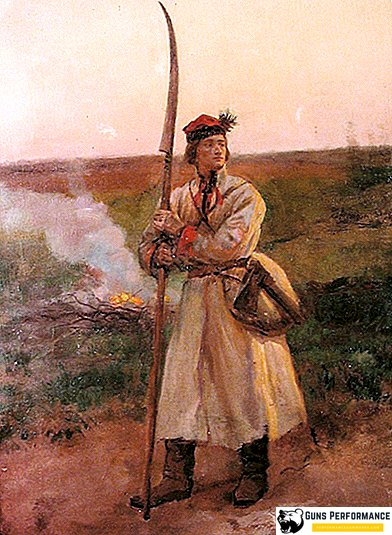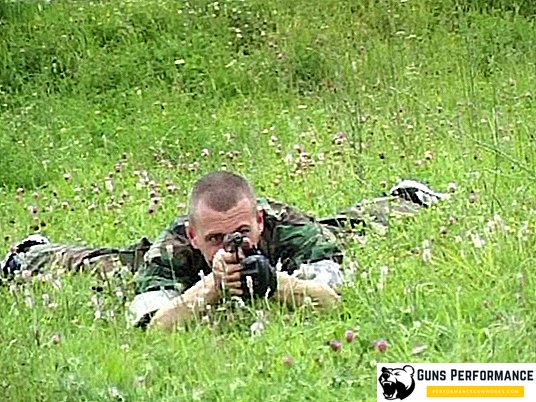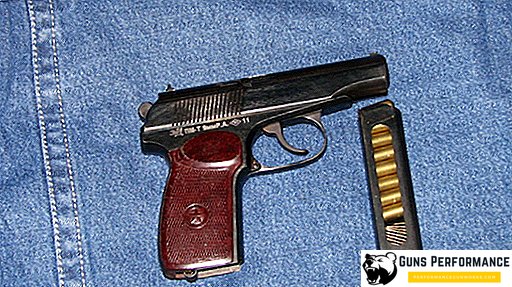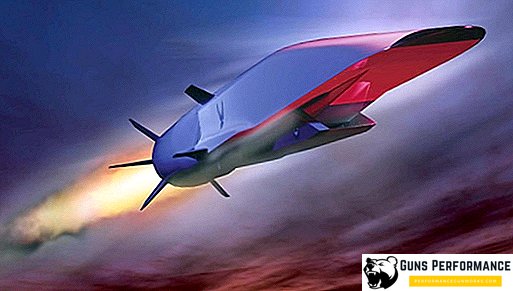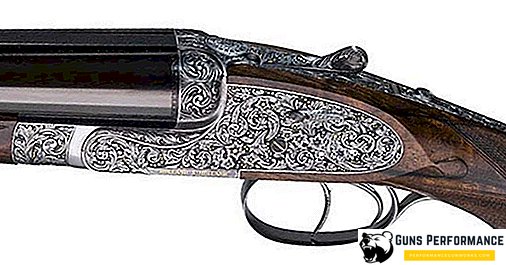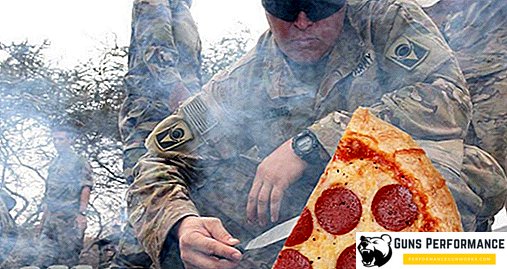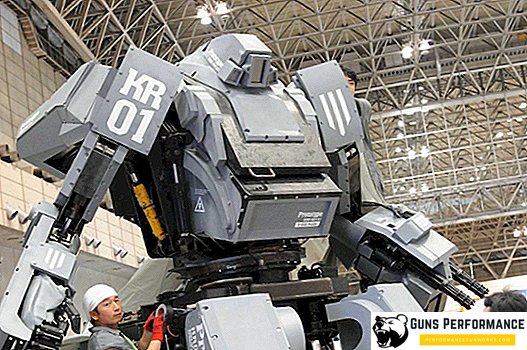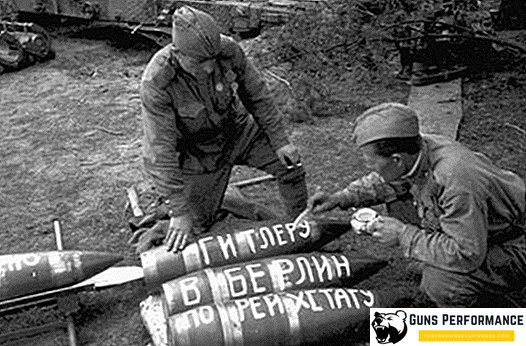The results of the Korean War clearly showed that infantry, artillery, aircraft and naval forces cannot independently succeed in a military conflict. The tank continued to remain the king of the battlefield on land. All the most significant military operations, both tactically and strategically, at that time were carried out exclusively with the use of tanks. The opposing sides have constantly sought to maximize the number of armored units involved in the fighting. The confrontation during a military conflict took place not only on the battlefield, where the steel monsters collided with each other, but also in the design offices.

The new T-44 and T-54 tanks that replaced the legendary T-34-85 combat vehicle became a transitional option. Despite the fact that the new tanks received a new turret, weapons and a number of other constructive innovations, the result was improved versions of the legendary T-34. If the release of the T-44 was launched during the Second World War, the T-54 tank was already a vehicle of the peace period. Soviet designers tried to take into account all the accumulated experience of past tank battles, but the new tank turned out to be damp. The Korean War, blazing on the Far East, put forward new requirements for armored vehicles, which formed the basis of the next machine.
As the base for the new tank, the last modification of the medium tank T-54B was chosen. The result of the work of Soviet designers was the appearance of the T-55, a fundamentally new tank. The new machine received very high tactical and technical characteristics, which provided the tank with not only the most massive production, but also made the car a long-lived one.
The birth of a new combat vehicle T-55
The fights on the Korean Peninsula have not died down yet, and in the Soviet Union they have already begun to think about how to improve the condition of armored forces and what the main tank of the armed forces should be. Three upgrades that touched the Soviet T-54 showed the need for a completely new tank. In the new development all the existing developments used in the previous vehicle were to be used in combination with the latest technical innovations in modern tank building.
Development of the new machine was launched in Nizhny Tagil at Uralvagonzavod in 1957, in parallel with the serial production of the T-54B tank. The new armored vehicle received the factory index "Object 155". It should be noted that all the main design activities around the tank of the new generation T-55 was conducted in an initiative manner. Technical specifications designers did not receive. There was no decision on the production of a new tank at the highest level. The only instance that could influence the work process was the military. The Soviet tankmen, relying on personal experience in the operation of the T-54 medium tank in the army, made their suggestions and wishes.

The first batch of new tanks consisted of two cars and was ready in 1957. On the new machines were used some components and parts from the medium tank T-54B. In particular, on prototypes towers from serial samples were used so far. During the year, both cars passed state tests, which showed the success of Soviet tank builders, and the right course of design ideas. The result of a long and painstaking work was the decision of the Council of Ministers of the USSR under No. 493-230 on the adoption of "Object 155" for the armament of the tank forces of the USSR Armed Forces. "Object 155" received a military designation tank medium T-55 and was launched in the series in the summer of 1958.
The main tasks that solved the designers of the T-55 tank
The medium tank T-55 had the main armament similar to its predecessor. The level of armor protection did not differ from the new car. The similarity of the main combat parameters of the two tanks led to the fact that in the West, the Soviet machine received the index T-54/55. Having no idea about the main technical features it was almost impossible to distinguish both tanks on the battlefield. The new tank had a weight of 36 tons standard for Soviet cars. Many parts, components and assemblies on the new machine were unified with the details of the T-54B tank, which had been in the series for quite a long time. This ensured the rapid establishment of mass production of the product and the development of the tank in the army. New equipment has a huge repair resource. For the first time, the stabilizers of the gun barrel were installed on a Soviet tank horizontally, which enabled the crew to fire on the move.

He won the T-55 and in comparison with its direct competitors, the machines of foreign armies. The Soviet car was one meter lower than the American Pershing tanks. The D-10T2S rifled cannon and the thickness of the armor of the Soviet vehicle didn’t compare with the American and British armored vehicles in their power and stability. Western experts, having received the first intelligence about the new Soviet tank, concluded: the Soviet T-55, a tank, is one and a half times more powerful in terms of firepower and protection than Western models. Unpleasantly surprised by the western military tank mobility on the battlefield. For their maneuverability, the Soviet T-55 had no equal for a long time.
However, the main feature of the new machine was the installation of an anti-nuclear protection system on it. In the era of nuclear weapons, this aspect was perhaps the key one determining the combat effectiveness of military units in the conditions of use of atomic weapons. Other significant innovations include the following aspects:
- the power of the main engine V-54 increased by 60 hp;
- increased fuel tank capacity and, accordingly, power reserve;
- an air compressor is installed to start the engine;
- the machine is equipped with a fire system "Dew";
- tank ammunition increased to 43 shots;
- The optical instruments for controlling the tank had a pneumohydro cleaning system.
For the first time, a new type of smoke equipment was installed on the combat vehicle. The smoke screen was created by injecting fuel into the exhaust manifold.
A significant difference from the T-54 tank was the absence of an anti-aircraft machine gun on the turret. The designers came to the conclusion that with the increased speeds of the aircraft, to fight in a similar way with low-flying targets is impractical. Only at the end of the 60s, the designers took into account the experience of military conflicts and returned the DShKM, installing it on the tower of the T-55 tank.
To the note: the appearance after 5 years of helicopters capable of fighting with tank formations on the battlefield made the tanks completely defenseless against air strikes. A vivid example of this is the Vietnam War, where American troops actively used assault helicopters.
It is important to note that the Soviet tank had a semi-automatic loading system, the most advanced for that period. Only Israeli tanks “Merkava 2 ″, after 10 years, appeared something similar to the Soviet development.

High performance and maintainability of the T-55 tank ensured high demand for the car. In the Soviet Union, the production of tanks was carried out for 21 years, from 1958 to 1979. During this period, more than 20 thousand models of T-55 tanks in various modifications were released.
The Soviet Union handed over a license and technical documentation for new equipment to its allies in the Warsaw Pact. Most of all tanks were produced in Czechoslovakia, more than 1,700 vehicles. Slightly less was released T-55 in Poland - 1500. In Romania, the tank under the symbol TR-580 and TR-77 was produced for 7 years.
The total number of T-55s produced in various modifications amounted to 23 thousand vehicles that were in service with armies in 60 countries of the world. If you add a Chinese modification of the Soviet tank, then the overall development of Soviet designers was the most massive - more than 100 thousand copies.
The design of the Soviet tank T-55 - the main features
Soviet tank builders, starting with the T-34 and IS-2 tanks, relied on equipping the vehicles with powerful and reliable power plants. Soviet V-2 diesel engines went through the whole war and earned recognition by the military. Similarly, the designers of an average T-55 tank also approached the task. The B-55 diesel engine had liquid cooling and provided the car with high speed characteristics and a large power reserve, both on hard surface and on rough terrain. The engine was started using compressed air, increasing battery life.

Increased engine power, increased reliability of the torsion bar suspension. The car had one of the best running parameters. The ground pressure was only 0.81 kg / cm2. The tank could immediately overcome the ditch 2.7 m deep and the wall, 0.8 m high.
For the first time, spare fuel tanks-racks were installed on the Soviet tank in the forward part of the armored hull. In the course of conducting field testing, this innovation proved its right to life. Fuel tanks filled with diesel fuel played the role of additional anti-cumulative protection.
If the Nizhny Tagil tank builders coped perfectly with the propulsion system and undercarriage, the armored vehicle had to work on the armament of the armored vehicle. As in the previous model, in the T-54B tank, the trunk stabilizers were installed in the horizontal plane on the new machine. It was necessary to increase the ammunition of a tank gun by increasing the number of cumulative armor-piercing shells. Tank 100-mm gun D-10T2S at that time was considered one of the most powerful. From a distance of 1000 m, the sub-caliber projectile, fired from this weapon, freely pierced armor 275 mm thick.
The tank used a new system of protection of the crew in case of use of weapons of mass destruction. Collective protection assumed complete sealing of the tank's fighting compartment. The life support systems of the machine provided a filtration and ventilation system. The crew of the tank was reliably protected not only from the shock wave, light radiation and radiation, but also could fight in the prevailing conditions.
Modernization of the T-55 tank
The appearance of a new Soviet tank for many years has determined the development of not only the domestic tank building, but also influenced the construction of tanks abroad. The car turned out to be a huge technological resource, which allowed to carry out painless upgrades of the product already in the process of mass production. The most successful modernization of the T-55 tank was made in 1983. The world saw the new car T-55 AM. Due to minor investments in the tank, it was possible to significantly increase the durability of armor protection, while maintaining the basic mobility of the machine at the same level. The upgraded tank received a new diesel engine V-46-5MSV, the power of which was higher than the previous propulsion system for 100 hp.

The main goal pursued by the modernization of the T-55 tanks was to bring serial products into line with the new standards. A new equipment was installed on the machine, thanks to which the firing characteristics of the tank were improved, and the combat vehicle control system was improved. The main changes in the design were made as a result of the combat use of tanks in Afghanistan, where tank units were part of a limited contingent of Soviet troops in the DRA.
The tank received an additional level of protection, which was calculated taking into account the combat opposition of armored vehicles with anti-tank weapons.
The Soviet medium tank T-55 for a long time became one of the main tanks of the Soviet Armed Forces. The machine became the base platform for subsequent developments in the field of tank construction. High characteristics of the tank marked its wide scope and geography of operation. The Soviet machine has successfully established itself in the sands of the desert and in the mountains. No wonder in many countries of the world the T-55 tank continues to be in service. Despite the fact that the modernization of the T-55 machine brought it closer to the level of the main armored vehicles of the new generation, the Soviet tank today has veteran status. Its combat use and operation is limited.


